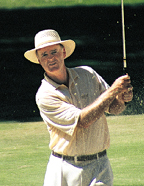
Looking for 3rd title
FT. WORTH, Texas (Sept. 18, 2008)--The tops seniors from around the world have converged on Shady Oaks, Ben Hogan's home course in Ft. Worth, Texas, for the 54th U.S. Senior Amateur.
As usual, amateurgolf.com will have daily updates from the event, but first we'd like to give you some preliminary players to watch as they move through the field.
Stan Lee is the returning champ, and has been playing solid all season, including making the cut at the U.S. Senior Open.
Paul Simson won the British Senior Amateur and is currently the No. 1 ranked golfer in the amateurgolf.com - Bridgestone Golf Senior rankings. Second-ranked Mike Bell of Indiana has seemingly been in the top-10 of every major event he's entered this year.
Other golfers to watch include two-time winner (and amateurgolf.com member) Kemp Richardson, Stu Grendahl and the always dangerous New York golf legend George Zahringer.
The Shady Oaks club was the brainchild of Marvin Leonard, born in 1895 in rural East Texas, who arrived in Fort Worth in late 1918, and became a successful merchant, businessman, entrepreneur, philanthropist, sportsman and visionary.
On the advice of his doctor, Leonard learned to play golf in the 1920s at Glen Garden Country Club where the young caddies, Ben Hogan and Byron Nelson, worked. An experiment with growing bentgrass at Glen Garden led Leonard to build Colonial Country Club in 1936 as a championship course.
Using the bentgrass, which provided fine putting surfaces, enabled him to convince the USGA to bring the 1941 United States Open to Fort Worth. By the mid-1950s, Leonard began to consider building a new course in the city, one that would be purely for membership play. His vision was for the ideal club with a small membership of “nice, compatible people” where the member would be king.
In the 1940s and ‘50s, the Leonard family spent their summers in northern California to escape the Texas heat. By August of 1955, Leonard found a perfect site north of San Francisco for a golf course and was on the verge of buying it when his attorney, Jenkins Garrett, called from Fort Worth to tell him of a large tract of land for sale seven miles northwest of downtown.
Leonard was familiar with the land, owned by the estate of the recently deceased Amon G. Carter, publisher of the Fort Worth Star-Telegram and “Mr. Fort Worth,” and caught the night train back from California. Leonard and Carter had, in fact, toured the land the year before, when Leonard had eyed it as a site perfect for a golf course. Carter left a note that upon his death Marvin Leonard was to be the first person offered the land. On Oct. 4, 1955, the 1,400-acre tract was purchased for $1,500 an acre, the estimated $2 million investment to be turned into a residential subdivision and golf course.
Before signing the papers to buy the land, Leonard walked the property with his good friend Ben Hogan, who tried to dissuade him from the project. He thought the site was far too hilly and rugged to make a playable and interesting course for the clientele Leonard wanted to attract.
However, Hogan’s opinion did not deter Leonard, who secured golf course architect Robert Trent Jones and the firm of Hedrick and Stanley as architects for the clubhouse.
Construction began in 1956 with Leonard taking a personal interest in all aspects of the new club. Along with the 6,320-yard, par-71 championship course, which was intended to be fun and relaxing, was a “Little Nine” of 1,200 yards, a perfect place for children and beginners to hone their game. By the time the course and clubhouse were completed, Leonard had spent more than $3.5 million dollars.
The initiation fee of $6,500 was the second highest in the state of Texas, but the oil industry, booming when the club was under construction, slumped in the late 1950s resulting in a smaller membership than anticipated. In 1968, after managing and supporting the club for many years, Leonard sold Shady Oaks to its members. Over the years Marvin Leonard’s original vision for a club with a small, high quality, congenial membership has not changed. It is truly member-oriented with no tee times and very few rules.
Certainly, Shady Oaks’ most famous member was Ben Hogan, whose daily routine included mornings at his office followed by lunch at Shady Oaks at the same large, round table where he could watch the action on the practice tee as well as the ninth and 18th greens. He then would go out with his shag bag to the Little Nine to a spot near the 18th teeing ground for practice.
Despite his reputation for being cold and aloof, Hogan showed many kindnesses over the years to Shady Oaks’ members and staff and befriended the club’s dogs, Max and Buster. Today, Hogan’s lockers containing clothes, hats, shoes, equipment and medicinal supplies stand outside the Golf Shop just as he left them.
One of Hogan’s most lasting contributions to Shady Oaks was the mentoring of a young assistant golf professional, Mike Wright, who came to the club in 1984. When head professional Art Hall unexpectedly passed away, Hogan encouraged Wright to pursue the position, though he was just 23 years old, and even offered him his jacket to wear to the interview with the club president. Now director of golf, Wright’s long tenure has been important to maintaining the level of service to the members and high standards throughout the club that Marvin Leonard set in 1958.
--USGA content used in this preview